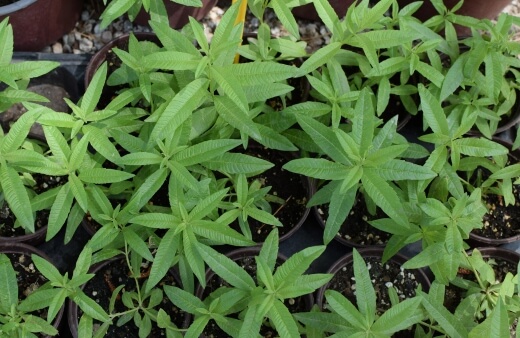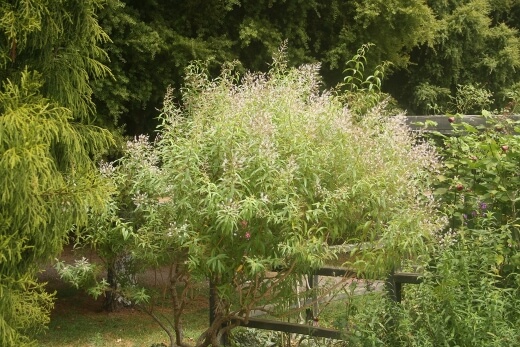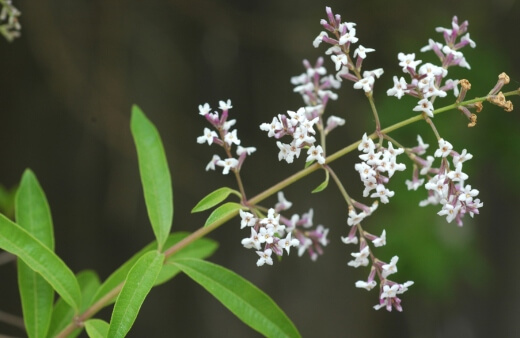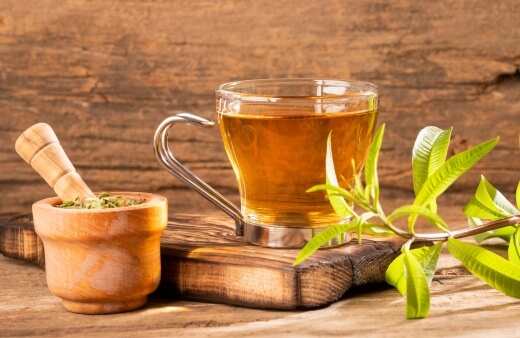The woody lemon verbena has these gorgeous green and glossy leaves that just seem to double overnight when the weather is hot. The more you harvest, the more they give you.
I love the citrus smell that it gives to a garden and of course it’s a gem for cooking when you need a lemon flavour. I’ve often used it instead of fresh lemons and keep a regular stash of dried leaves for future use.
Our guide offers some insight into the lemon verbena shrub, including how to propagate your own one using cuttings, and also how to plant and care for it. If you want to be on the lookout for pests and diseases, we’ve got info about those too.
More...

Family: | Verbenaceae |
|---|---|
Genus: | Aloysia |
Species: | A. citriodora |
Origin: | South America |
Common Names: | Lemon verbena, lemon beebrush |
Location: | Indoor and outdoor |
Type: | Shrub |
Growth: | Up to 3 metres tall and wide |
Sun requirements: | Full sun to part shade |
Foliage Colour: | Green |
Flower Colour: | White, lavender |
Flowering: | Spring and summer |
Fruit: | None |
Maintenance level: | Medium |
Poisonous for pets: | Yes |
Introducing Lemon Verbena
Lemon verbena, also known as lemon beebrush, became part of the Western world around 1794, when it was discovered from Chile and Argentina. Since then it has earned itself popularity as a much loved garden shrub, but also a valuable cooking ingredient and natural healer.
The botanical names for this plant are Aloysia citriodora and Lippia citriodora, but Aloysia triphylla is more often used. Lemon verbena grows quickly and the strong and lemon heavy scent from the leaves makes for a great sensory experience. This fragrance is ultimately why lemon beebrush is grown so much.
Lemon Beebrush Plant Features
In terms of size, lemon verbena can reach 3 metres in height and can spread out up to 3 metres as well. This shrub has long and thin leaves, and flowers that arrive late in spring and keep appearing into the summertime.
The flowers are small and are white or lavender. Lemon verbena becomes completely dormant in winter and then when spring brings longer days and warmer temperature, the new growth appears. If spring is still quite cold the new growth might only be seen at the start of summer.
Growing Lemon Verbena in Australia

Lemon beebrush is quite versatile and can be used as part of a herb garden, grown in a pot to live on the patio, or anywhere in the garden where you can take in the lovely scented leaves.
You can use sprigs of the lemon verbena to freshen up the air in your home by popping them into a vase or by making potpourri. Lemon verbena oil was in fact incredibly popular to use in the making of perfumes.
In addition to enjoying the fragrance of the shrub, you can use the leaves to make herbal tea and summery beverages, meat stuffing and salads.
Propagating Lemon Verbena
Lemon verbena is easy to propagate like other similar herbs, using cuttings that are semi-ripe and taken in the summer. It’s best to use a sharp tool for taking cuttings and the length should be around 10 to 15 cm. You need a stem without flowers and make the cutting just above a leaf node. You can remove all the leaves except for the sets at the top.
Use a rooting hormone if you have available but this is not an essential step. Plant your cuttings into a potting mix that has been moistened and aim for a depth of around 2.5 cm. Create humidity for the cuttings by putting a clear plastic bag over it that is sealed and then make a small cut to let a little bit of moisture out.
You’ll need to check your lemon verbena cuttings on alternate days to see if the soil feels dry in which case you need to add some water. You can also provide a light misting of water. Once a few weeks have passed, you can tug on the lemon beebrush cuttings to test for root development.
If you feel some resistance when you pull, you can remove the plastic bag and let the cuttings continue to grow indoors for another 2 weeks. Transplant your lemon verbena cuttings into a bigger container and put it in the sun until they are ready for garden planting in springtime.


Get Your Free Guide:
Master Growing Australian Natives eBook
A Must Have Complete Guide for Every Australian Garden
Get Your Free Guide:
Master Growing Australian Natives eBook
A Must Have Complete Guide for Every Australian Garden
How to Care for Lemon Verbena
Lemon verbena likes warm weather so the perfect time to plant it is during spring. Choose a garden spot where the plant won’t have too much shade from other plants or trees. It’s possible to encourage your lemon beebrush to grow along a wall or fence or even a trellis.
Here is our compilation of garden trellis ideas and kits for the best options in 2023.

Source: Auckland Botanic Gardens
Sunlight
Lemon verbena needs plenty of sun – this means full sun for between 6 and 8 hours per day. If you are growing the plant indoors you might need to provide some additional light. If you notice that your lemon verbena is dropping its leaves, it probably isn’t getting sufficient light.
Soil
Lemon beebrush will thrive in a rich loam soil, but it will accept other types of soil as well. Make sure you have really good soil drainage. Planting lemon verbena in a raised garden bed for example can help.
Watering Lemon Beebrush
This is a thirsty plant that needs regular water. The lemon verbena does not cope with too little water. It will start to drop leaves and becomes more at risk for pests. Finding the happy balance here means keeping the top of the soil moist but not overwatering the plant as the roots don’t like to be wet.
If you are growing your lemon beebrush inside, you can keep them drier and water them once per week.
Climate
If you think of the native home of the lemon verbena which is South America, it needs a sunny and warm climate. If temperatures drop too low, the plant will drop its leaves and go into a dormant state. Dry or humid conditions are preferable. Lemon verbena is also very sensitive to frost.
Fertiliser
Lemon beebrush loves regular fertiliser and responds with plenty of lush growth. You can feed your plant during spring with an all-purpose fertiliser. Another great way to nourish your lemon verbena is to water using compost or something like manure tea when the plant is in the growing phase.
If you prefer to make your own compost, check out our review of the best compost bins in Australia.
Pruning Lemon Verbena
Lemon verbena has a tendency to become quite woody over time and they might even look a bit worse for wear. You can prune back your plant by a third or half of its size. It’s best to do this early in spring and the result will be new growth that is thicker and more compact.
Lemon Verbena Pests to Look Out For

Aphids
Aphids like to hang out on any new plant growth or in the crevices of leaves. They can be a range of different colours. When the aphid infestation becomes too much, the plant might start to die.
The symptoms of this pest are reduced plant growth, leaves that look mottled but are also yellow and curling, and a wilted look. The aphids feed on the juices of the plant but they also spread disease.
Check your lemon verbena often for aphids and if you spot them, you can either squash or remove them if possible. If you can introduce helpful insects like ladybirds, they will happily help keep aphid populations under control.
If the size of the infestation is small, you can use a strong spray of water to knock the aphids off the plant. Applications of neem oil are a good follow up treatment.
Slugs and snails
Snails and slugs like to feed at night and you’ll usually notice lots of holes in your plant leaves. Some types of slugs live below the soil and like to munch away on roots.
Some nurseries have physical structures you can put in the garden to protect plants, but the best and simplest way is to get rid of the pests by hand whenever you see them. Other methods of treatment include using iron phosphate pellets.
Lemon Verbena Frequently Asked Questions

How can lemon verbena be used in cooking?
The herb works well for a roast and can add sweetness to a dessert too. Equally delicious are its use together with olive oil for salad dressings, to make ice cream and jelly, and for soup.
What are some of the health benefits of lemon verbena?
This shrub has been said to provide protection for muscles against any damage, to promote better sleep, and to assist with weight loss. Lemon verbena is a great tonic to help with indigestion, colic, and constipation.
Does lemon verbena have any benefits for the skin?
This plant has a healing and toning effect, but is also anti-inflammatory which can help with acne. Lemon verbena works well to get rid of dirt, toxins and sebum on the skin.
How do I harvest Lemon beebrush?
You can harvest the leaves of your plant when it’s at least 25 cm in height and there are a few leaves on each of the stems. The leaves of the Lemon verbena have the most flavour when the plant is flowering.
When you harvest, make sure you don’t take off more than a quarter of a stem so that the shrub can achieve new growth. You’ll find the leaves quite tough and will need to first crush them before use.
The small flowers of the Lemon beebrush also have the same lemon scent and you can use them as you would with the leaves.
Is it possible to grow Lemon verbena in a pot?
Growing the shrub in a pot is a great way to keep the Lemon verbena happy, especially if you live somewhere cold as you can then move it around as needed. You can also better control its size.
When you choose a suitable pot, it needs to be at least twice the size of the root ball and have plenty of drainage holes. You can add some leaf mould or compost to the soil, and keep the pot in full sun. Give it water every day and add some fertiliser every couple of months.
Can you grow lemon verbena indoors?
The lemon beebrush can grow quite big but if you have space inside and a spot with enough sunlight, it is possible to grow inside. You’ll need to do some regular pruning to manage the size.
Looking for other herbs to plant in the garden, or just wanting to get some gardening advice? Sign up for our newsletter.
Wrapping Up Our Lemon Verbena Guide
As far as lemon fragranced herbs go, lemon verbena is the top of my list. It offers the most intense flavour without being bitter. I love adding it to drinks and baked treats. You need to be consistent with its care, but the effort you put in is well worth it.
Published on May 31, 2023 by Maisie Blevins
Last Updated on September 9, 2024




